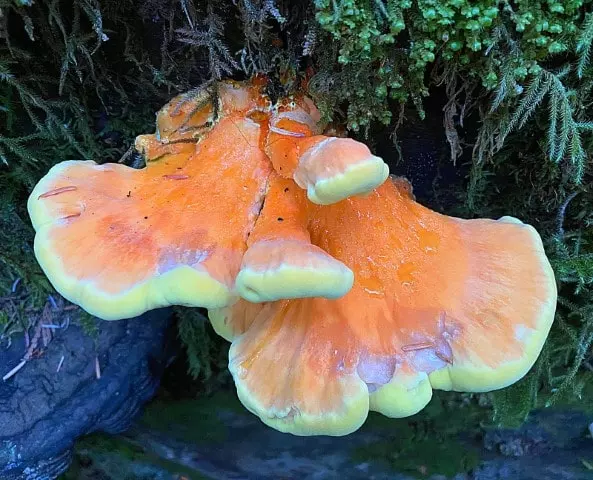Surely, after a few days of rain or in the wettest times of the year, your garden is full of wild mushrooms, right? I also get them on tree branches, grass, mulch, and any decoration that has some wood in my yard. I imagine you are wondering if it is safe to eat these wild orange mushrooms or if they are poisonous for dogs (mine are always sniffing them). Unfortunately, while some are edible, they are also challenging to identify, so I advise you to be very sure before eating them. Over the years, my wife and I have tried to get rid of them in various ways that are safe for our pets and do not harm the grass. In this post, I summarize what the most common wild orange mushrooms in the yard are, how to identify them (video included), and the successful ways to permanently get rid of those unwanted fungi that appear in the garden, including some pet-safe methods without killing the grass in the process.
Not all orange mushrooms that grow in the yard are toxic to humans and animals. Throughout this article, I will show some orange mushrooms that grow in the yard and are not toxic.
Some orange bonnet mushrooms are poisonous, while others are safe to eat. I do not recommend collecting the orange mushrooms that grow in the yard for consumption; only collect them if you are sure of the species that grow in the area where you live or if the local authority gave you the correct information.
Check out this video that shows the most common orange mushrooms you may find in your garden.
Table of Contents
What Are the Orange Mushrooms in Yard
What Are the Orange Mushrooms in Yard? The orange mushrooms are a variety of fungi that appear due to the abundance of organic matter in the yard and the favorable climatic conditions for their development, such as temperature and humidity. Over the years, we have seen different species growing in our garden. As gardeners, we have always asked ourselves the same questions. What is orange fungus in my yard?
The appearance of orange mushrooms in yard is not a bad thing. It indicates that organic matter is abundant in the soil. Some of the most common orange mushrooms that appear in the yard, on the grass, and over the mulch are Jack-O’lantern mushroom, Sulphur Shelf Mushroom (Laetiporus), Orange Peel Fungus (Aleuria aurantia), and Spring Orange Peel Fungus (Caloscypha), among other less popular orange bonnet fungi. The most common species of orange mushroom is the Jack-o’lantern mushroom, which is highly toxic to both humans and animals.
Of course, there are also varieties of orange mushrooms that are edible, such as the orange peel fungi that can be eaten. In the following paragraphs, we will explain the different varieties of orange mushrooms that grow in the yard.
Why Do I Have Orange Mushrooms in Yard
Why Do I Have Orange Mushrooms in Yard? The wild fungus appears when the pH of the available organic matter is optimal, as well as the temperature and humidity conditions. After the rains, orange mushrooms usually appear, and even more so if there are conditions of moisture and temperature suitable for the orange mushroom.
After the rains, look in the bushes, trees, or decaying wood, and you will probably see a mushroom. Orange mushrooms often appear on the lawn, which indicates an abundance of organic matter.
If you have pets or children in your yard, it is advisable to remove the orange mushrooms to avoid intoxication problems. Children are very curious and when they see an orange mushroom, they could touch it. In the following paragraphs, I will explain how to remove orange mushrooms from the yard.
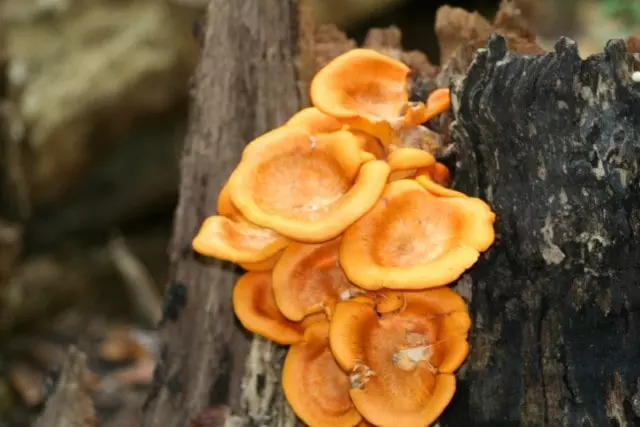
Are Orange Mushrooms Poisonous or Edible
Are Orange Mushrooms Poisonous or Edible? There are many species of orange mushrooms; some orange mushrooms are poisonous, and other species are safe to eat (edible). For example, the Jack-o’lantern mushroom is toxic to humans. Even if this mushroom is cooked, it is toxic.
On the other hand, the orange peel fungi are suitable for consumption, but it is difficult to identify and could be confused with poisonous mushroom species such as Otidea or Caloscypha, which are also orange mushrooms.
If you are really interested in collecting mushrooms for consumption, I recommend joining a mycology club, where you will learn about all kinds of mushrooms. A list of various mycology clubs can be found on the North American Mycological Association website.
Also, our most recent article summarizes essential guidance for the identification of Wild Orange edible mushrooms.
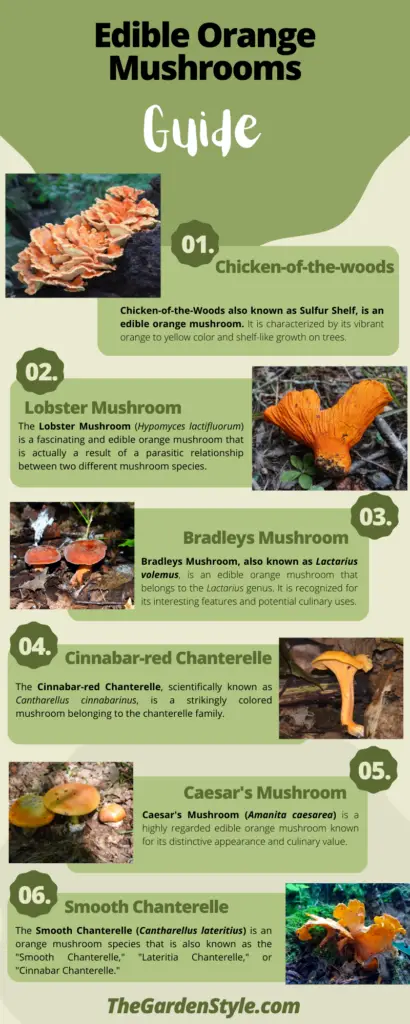
Most Common Orange Mushroom Species in Yard or Lawn
What kind of wild mushroom is orange? There are different species of orange mushrooms; some species are poisonous, and others are not poisonous. Here, I will describe four varieties of orange mushrooms that grow in the yard: Jack-O’lantern mushroom, sulfur shelf mushroom, orange peel fungus, and spring orange peel fungus.
Jack-O’lantern Mushroom
The Jack-O’lantern mushroom is one of the most common orange mushrooms that grow in the yard easily. This mushroom is very striking and easy to identify. Jack-O’lantern Mushrooms are very toxic because they contain illudins.
Illudin, in its natural state, is highly toxic to humans and pets and can cause vomiting, diarrhea, difficulty breathing, and cramps. In a study by Erasmus University, they found that illudin has strong antitumor activity.
Jack-O’lantern mushrooms normally appear on decaying trees or any decaying wood. Many people confuse these mushrooms with other edible orange mushrooms.
There are three varieties of Jack-O’lantern mushroom, and they are as follows:
- Omphalotus illudens: It grows in eastern North America, so it is also known as eastern jack-o’lantern mushroom.
- Omphalotus olearius: It grows in the forests of Europe, although it has also been found in parts of South Africa.
- Omphalotus olivascens: This mushroom grows in California and Mexico, and is known as western jack-o’-lantern mushroom.
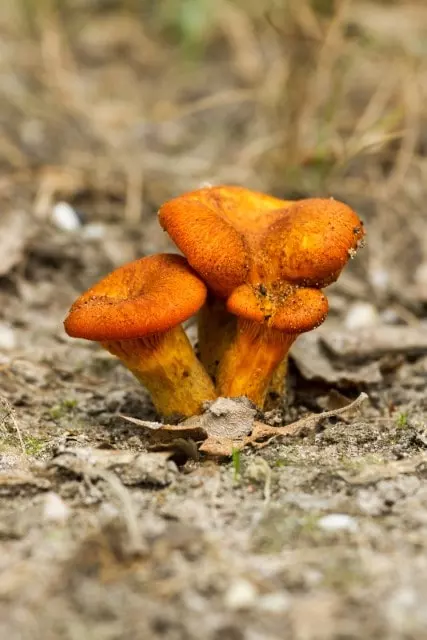
Sulphur Shelf Mushroom (Laetiporus)
Another common orange mushroom species is the sulfur shelf mushroom, also known as chicken of the woods and chicken mushroom. This species of orange mushroom is very easy to identify.
Sulfur shelf mushrooms are orange or bright yellow, as the shelf mushroom matures, they become dull white. These mushrooms grow on trees and decaying wood.
Sulfur shelf mushrooms are edible, like orange peel fungus. They have a chicken-like taste. That’s why these mushrooms are also called chicken of the woods. It is recommended to consume these mushrooms cooked and never raw.
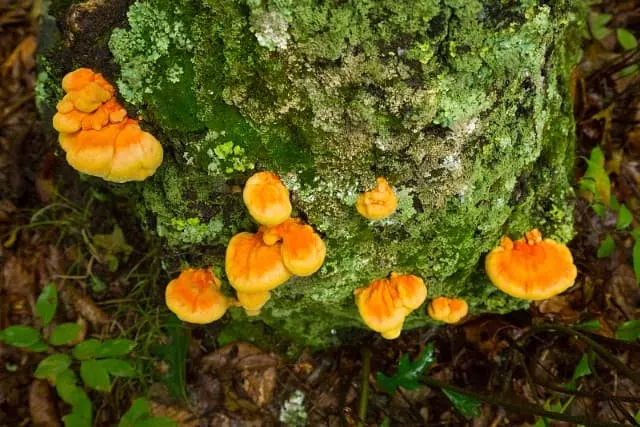
Orange Peel Fungus (Aleuria aurantia)
During the fall and summer, it is very common to observe orange peel fungus in North America. These mushrooms are bright orange and cup-shaped.
Orange peel fungus is not toxic. Therefore, they are edible, like sulfur-shelf mushrooms. These mushrooms are not as tasty as other species, but are suitable for consumption.
Normally, orange peel fungus grows on the grass in the yard and near decaying trees or wood. In Europe, there are two species very similar to the orange peel fungus, but they are toxic and not suitable for consumption.
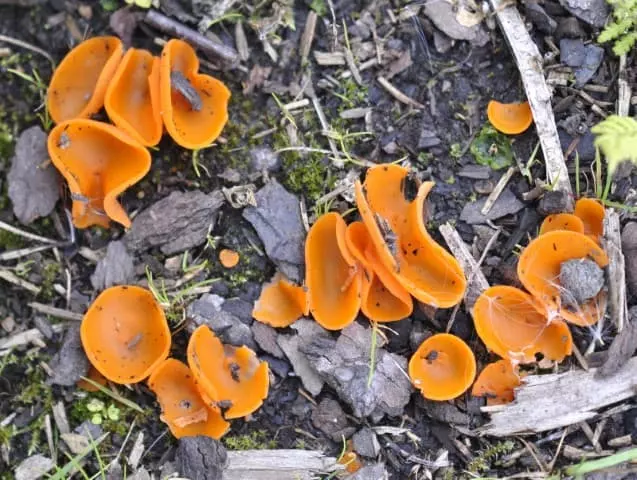
Spring Orange Peel Fungus (Caloscypha)
Spring orange peel fungus is cup-shaped and grows up to 1.5” (4 cm). These fungi grow on the ground of coniferous forests, appearing after the snow melts in the forests during the spring.
Spring orange peel fungus is not edible and is occasionally confused with the edible orange peel fungi.
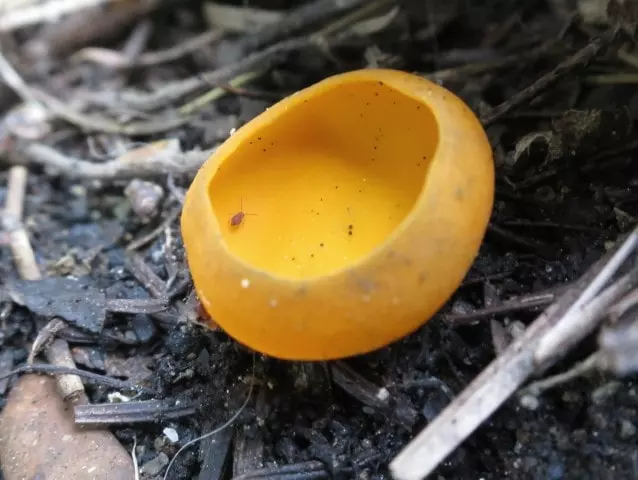
How to Get Rid of Orange Mushrooms from Your Yard
There are several ways to get rid of orange mushrooms in the yard. Many of them are pet-safe and permanent, while other ones are simple and cheap but need frequent garden or lawn treatment. You can either pull the orange mushrooms by hand (using gloves) or use a fungicide to kill the fungi so that they do not grow back. Next, I will explain some methods to get rid of orange mushrooms from the yard.
The three most effective and economical ways to get rid of orange mushrooms in your yard are the use of vinegar or baking soda and the application of fungicides. Let’s see different effective methods, and you will choose the one suitable for you.
The most effective way to get rid of orange mushrooms in the yard is to use a fungicide. First, wear gloves (for extra protection) to remove the orange mushrooms, and then apply the fungicide according to the manufacturer’s directions. Applying the fungicide will prevent the fungus from growing back.
On the other hand, if you do not want to use a fungicide, you can use vinegar. Mix vinegar and water in a spray bottle in a 1:4 ratio. An easy example would be 1 cup of vinegar and 4 cups of water. Apply the water and vinegar mixture only on orange mushrooms; avoid using the mixture on other plants.
Alternatively, you can use baking soda and water to remove orange mushrooms from your yard. Mix 1 tablespoon of baking soda in 1 gallon (3.8 liters) of water and apply it to the mushrooms. The baking soda will increase the alkalinity of the soil, and fungi will not proliferate.
These three are the most effective and economical ways to get rid of orange mushrooms in your yard. Use whichever of these three methods best suits your yard.
If you also have a significant growth of fungus in mulch, there are more successful methods you should check in our post about How to Get Rid of Mushrooms in Mulch.
Final Conclusions
As you have learned in the article, there are many types of orange mushrooms, some of which are edible and others are not. As it is very difficult to differentiate between edible and inedible orange mushrooms, I recommend not taking the risk. As mentioned above, you can join a mycosis club to learn more about fungi.
I hope this article about orange mushrooms in yard will be helpful. Learn more about how to get rid of mold in plant soil.
